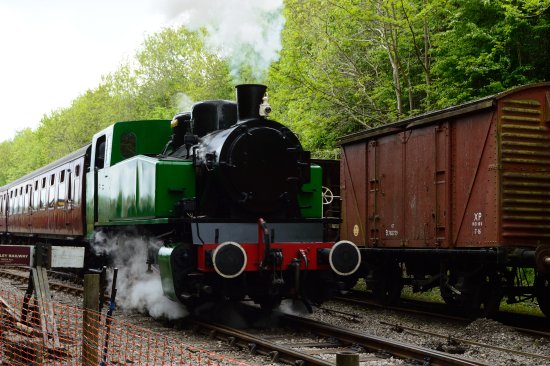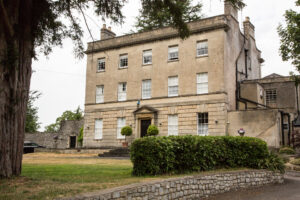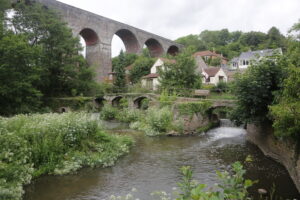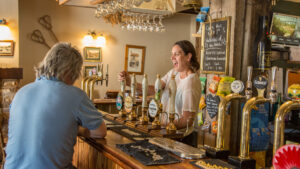Bitton to Pensford
This section is between the cafe at the Avon Valley Railway station, Bitton, to the Rising Sun pub and gardens in Pensford.
Both directions are the same except for the short one-way section along Church Street in Pensford.
Highlights
Bitton to Pensford

Avon Valley Railway Station and Cafe
I think of this as the hub of the Avon Cycleway – a great meeting place for cyclists on the Bristol and Bath Railway path, and great fun when the steam train comes through. The railway is a preserved portion of the Midland Railway Mangotsfield and Bath Branch Line, which was closed during the late 1960s as a result of the Beeching cuts. It’s the busiest part of the Avon Cycleway, by a long way, and a great place to come for lunch in one of the converted carriages. You can ride on the train a mile north to Warmly and a mile south towards Bath.
Head off down the Bristol and Bath Railway path, across the river Avon. After a couple of miles, we leave the path at Avon Lane and head into Saltford. There are some nice walks by the river around here. Details are on the Saltford Environment Group website.
Detour: After leaving the B to B path and joining Avon Lane, at the bottom of the hill a left turn offers a short picturesque and flat riverside diversion along Mead Lane to the Jolly Sailor pub.

Saltford old town
If you’ve only experienced Saltford in the car on the way to Bath, then you’ll have missed what I call Saltford Old Town. Turn right onto Mead Lane, under the cycylepath and past the Bird in the Hand pub. You’ll pass a collection of lovely stone cottages. Next to the church is a privately owned house – Saltford Manor – which apparently is the oldest continuously inhabited house in the country – bits of which may go back possibly to the twelfth century. Not open to the public though! The Heritage Centre is to the right – open occasionally. Further on is Saltford House, and next to it is Brunel’s Tunnel House, so named when the GWR Bristol to London line was built directly under it. The property was bought in April 1836 by Isambard Kingdom Brunel and conveyed to the Great Western Railway company in December 1837; the line was opened in 1840.
Take a left at Beech Road into modern Saltford and over the A4 Bath road into Manor Road. Just here, on the right is the Little Coffee Shop which is a very nice spot to catch coffee and cake. Keep going and take a left onto the Old Manor road – a bit confusing – and immediately left up a long leafy lane before crossing at the intersection of Gypsy Lane and Ashton Hill. Straight across and then right into Middlepiece Lane. Cross the B3116 and continue through Burnett. It’s a lovely, if a bit up and down, ride all the way to Compton Dando.

Compton Dando
There are 22 Grade 2 listed building here, so plenty to look at if you’re not in a hurry. You can get to the church by taking a short detour up, you guessed it, Church Lane. It is open occasionally. I mentioned the listed buildings; one that you might be surprised at is the K6 telephone box Designed in 1935 by Sir Giles Gilbert Scott. All sorts of things can be listed, not just buildings. I was told that there was another one in Burnett. The Compton Inn is listed and is very popular here.
Climbing out of Compton Dando, take a right up Cockers Hill. It’s uphill all the way for nearly a mile then right onto Hunstrete Lane. In half a mile we reach the village of Woolard, which consists of a few cottages divided by the river Chew. Some of the cottages are really cute, such as the four in Paradise Row. Hunstrete Lane now becomes Publow Lane. After half a mile of ups and downs, we get to Publow.
Publow
The two highlights are the church and the bridge. The Church of All Saints dates from the 14th century has a 15th-century tower with gargoyles. I think the bridge is more interesting. It had to have some very difficult renovation work done on it, made more difficult by the presence of two protected species: Daubenton’s bats, which were roosting in cavities under the bridge, and white clawed crayfish in the river below. I had a look in the river, but couldn’t see any crayfish. The renovation got an award from the Institute of Civil Engineers.
Then down the hill into Pensford; but before we cross the main A37, you’ll see a memorial bench commemorating the great jazz clarinettist, Acker Bilk, who lived here. Across the road and into the village we’ll stop at the Rising Sun pub.

Pensford
The village is dominated by the Pensford Viaduct. It was built in 1874 to carry the Bristol and North Somerset Railway over the valley of the River Chew. Damaged in the 1968 flood and not now in use, it’s one of what used to be called the ‘burdonsome estate’ – a wonderful name for structures such as bridges, tunnels and viaducts that no longer have a use, but still have to be maintained, as stipulated in the original building contracts. These are now the responsibility of the government. Sustrans has bought up many to maintain them as places to cycle and walk.
The Church of St Thomas a Becket has an interesting history. Almost surrounded by water, it has been damaged repeatedly by floods, especially the 1968 mega-flood. It was then deconsecrated and bought by a young couple to convert into their home. The project was filmed for the first episode of the BBCs Restoration Home series.

Rising Sun pub Pensford
Let’s stop at the Rising Sun – one of my favourite lunchtime stops on the ACW – nice food and a lovely garden by the river underneath the viaduct. That’s it for this leg of the ACW. From here we go to Chew Stoke.
